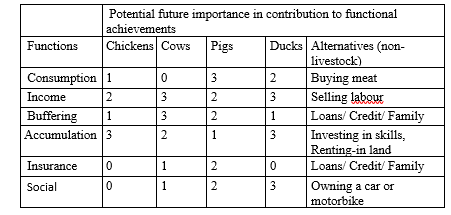You are here
Rating of Animal Productivity
Farmer ratings can be used to evaluate a new breed or how a management practice or technology has affected production, even without estimating the actual changes in production. These ratings can be carried out as a participatory exercise where farmers identify the important attributes and rate the alternatives by these attributes. Separating the analysis by type of farmer or by gender may provide useful information about how various groups perceive the alternatives and what attributes they prioritize.
Ratings (or scores) are generally easier to analyze statistically than rankings (see details in Measurement method 1: Farmer reported production).
How to operationalize the metric
Method of data collection and data needed to compute the method:
The following method to collect matrix rating data on animal productivity is an excerpt from “A guide to indicators and methods for assessing the contribution of livestock keeping to livelihoods of the poor” by Dorward et al. (2005).
Species, function and alternatives matrix (Excerpted from Dorward et al. 2005, pp.20-22)
Purpose: to identify potential livestock species and livestock keeping activities of beneficiaries, the functions of such livestock keeping for each species, and alternative (non-livestock based) ways of achieving these functions
Contribution: Determination of beneficiaries’ priorities & options in livestock keeping
Activity: Construct a matrix for ranking species according to the potential future importance of their contribution to different functions.
Species, future functions and non-livestock alternatives:
Method: This activity builds on activity 1 and takes it further by looking at the potential importance of livestock (and other activities) in achieving important functions in the future. The prioritisation of functions can be taken from matrix 2 (Functions, priorities & preliminary indicators) with appropriate discussion of the ways that functions’ importance may change in the future. Then for each function the potential contribution of different species and of alternative non-livestock keeping activities should be ranked (or scored) with regard to their relative importance in fulfilling livelihood functions in the future.
Example: Species, future functions and non-livestock alternatives matrix for crop- livestock farmers, Yapacani, Bolivia.
 The process of discussion in order to complete this matrix should stimulate thought on the nature of change for both researchers and beneficiaries, which can be very useful. It is essential that reference is made to identified functions and the processes of change when discussing the changes in the relative importance of functions fulfilled by keeping various species. In our example chicken is becoming more important in consumption, probably due to its diminishing value due to the supply of cheap chickens nearby from a large chicken farm. Ducks’ importance as providers of buffering is perceived as increasing, probably due to their higher relative value compared to chickens.
The process of discussion in order to complete this matrix should stimulate thought on the nature of change for both researchers and beneficiaries, which can be very useful. It is essential that reference is made to identified functions and the processes of change when discussing the changes in the relative importance of functions fulfilled by keeping various species. In our example chicken is becoming more important in consumption, probably due to its diminishing value due to the supply of cheap chickens nearby from a large chicken farm. Ducks’ importance as providers of buffering is perceived as increasing, probably due to their higher relative value compared to chickens.
Unit of analysis:
The unit of analysis is the individual respondent and his/her perception of the attributes of each alternative.
Limitations regarding estimating and interpreting:
Farmer ratings provide only a coarse estimate of relative production of animals. Farmer ratings may not be easily compared across sites, especially if cultural factors vary, thus affecting the importance of various attributes.


